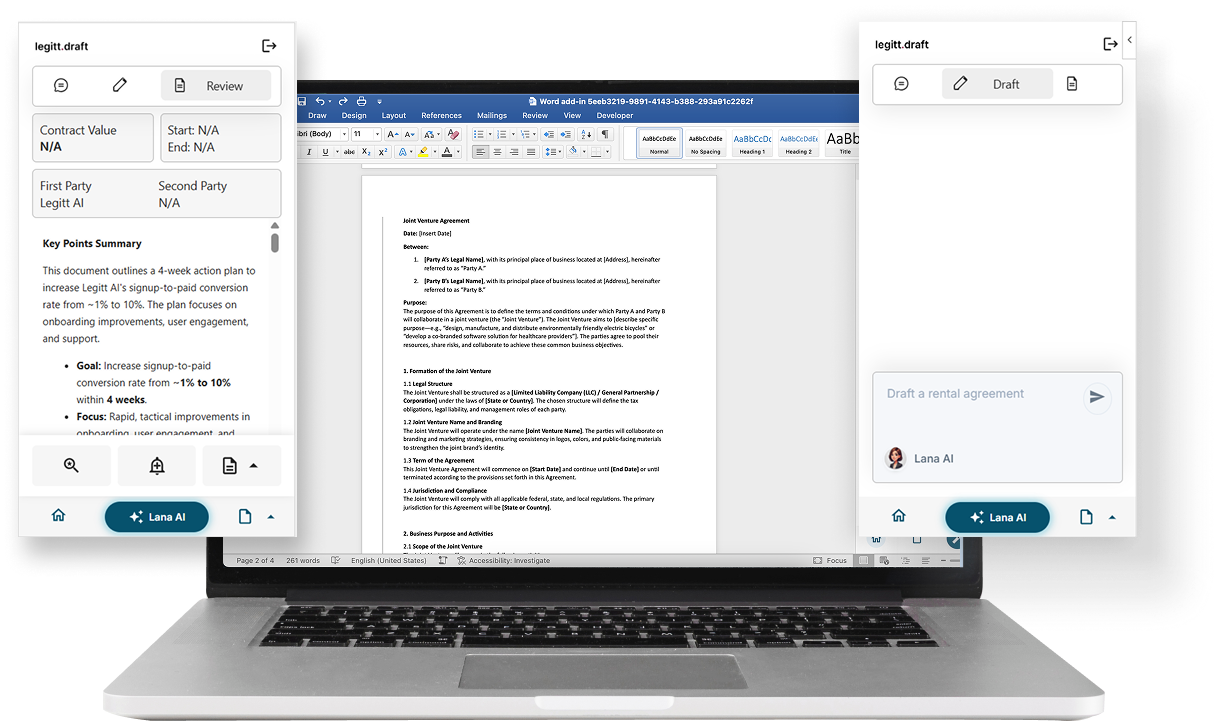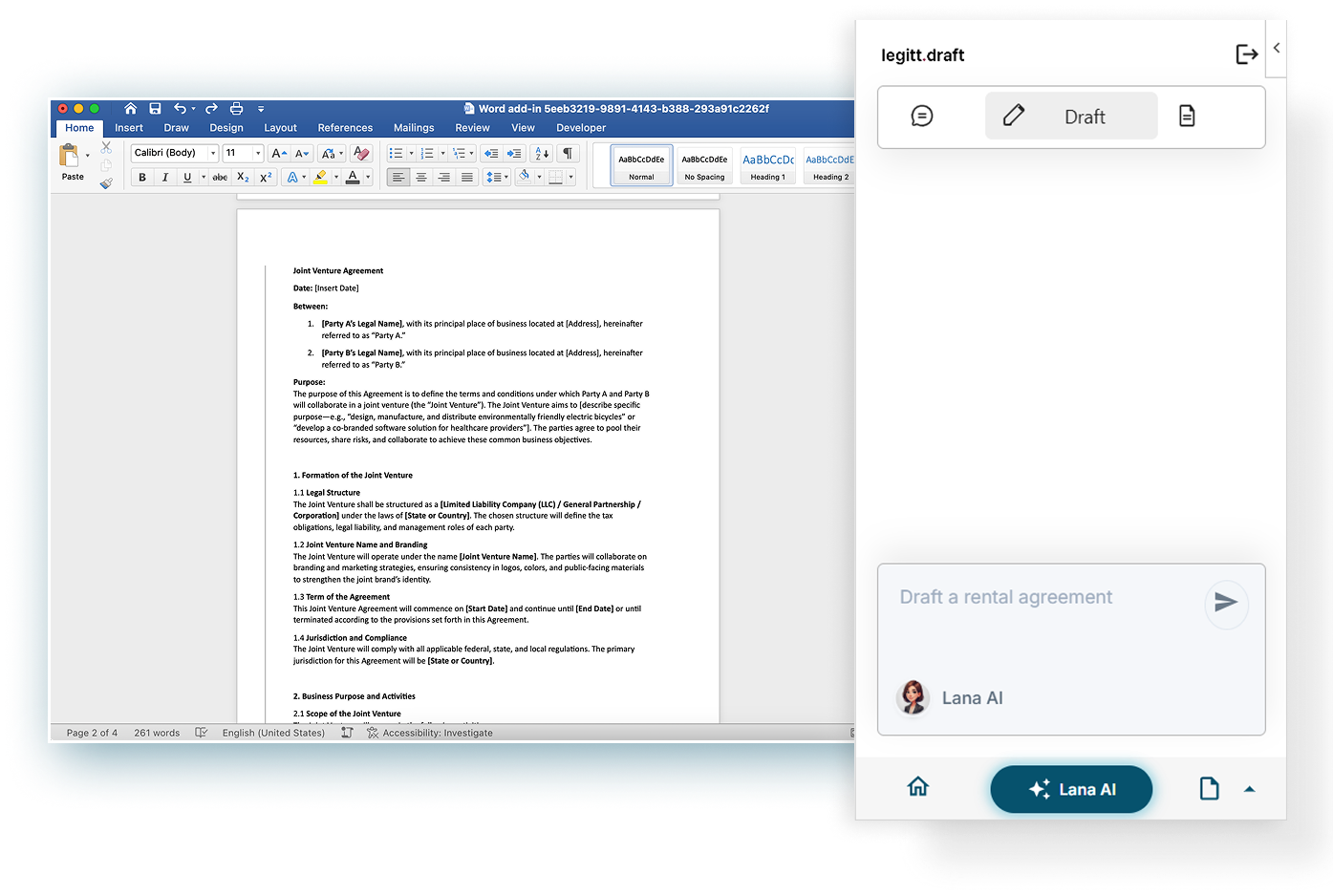Introduction
In the age of AI-powered productivity tools, legal professionals and businesses are rethinking how they manage contracts. Drafting contracts, once a time-consuming and complex task, is being rapidly transformed by intelligent tools designed to simplify and accelerate the process. Two leading names in this evolution are Harvey, the legal AI assistant for law firms built on GPT-4, and Legitt Draft, the world’s only contract drafting AI copilot embedded directly into Microsoft Word.
Though both aim to make legal work faster and more efficient, their use cases, audiences, and functionalities differ significantly. This article compares Harvey and Legitt Draft in detail, focusing on their applicability to contract drafting and why Legitt Draft may be the superior choice for organizations looking to streamline their contract lifecycle.
1. Purpose-Built vs General-Purpose
Harvey:
Harvey is a general-purpose legal AI tool. It is trained to assist with legal research, summarizing case law, generating legal memos, and supporting litigation tasks. While it can draft contracts using natural language prompts, this is not its primary strength.
Legitt Draft:
Legitt Draft is purpose-built specifically for contract creation, review, collaboration, and management. It is designed for legal professionals, business users, and operational teams that manage contracts daily. Its core architecture is optimized for understanding, assembling, and validating contractual language in real time.
Verdict: Legitt Draft is purpose-built for contracts, while Harvey is broader and less specialized.
2. Integration & Workflow Compatibility
Harvey:
Harvey operates through a chat-based interface, meaning users must prompt the AI and then transfer the output into their word processing tools for editing. This creates friction in the workflow, as users must move between platforms.
Legitt Draft:
Legitt Draft is embedded directly within Microsoft Word, where most contracts are already being drafted. It offers native access to clause libraries, approval workflows, redlining tools, and version history within the same environment.
Verdict: Legitt Draft integrates seamlessly into existing workflows, making it more efficient and practical for contract-heavy teams.

3. User Types Supported
Harvey:
Harvey is designed for trained legal professionals with expertise in formulating legal prompts and interpreting legal AI outputs. It assumes a high level of legal understanding from the user.
Legitt Draft:
Legitt Draft democratizes contract drafting. Legal professionals, salespeople, HR managers, procurement specialists, and founders can all use it effectively. It includes guided templates, plain-language explanations, and AI-assisted drafting.
Verdict: Legitt Draft supports a broader range of users across an organization.
4. Drafting Experience
Harvey:
Contract generation in Harvey requires users to input a structured prompt. The AI returns a full draft, but the language often needs manual refinement. There is no real-time clause-by-clause validation or contextual guidance during editing.
Legitt Draft:
Legitt Draft provides real-time suggestions as users draft inside Word. It recommends clauses, detects missing sections, and flags risky terms. It also provides definitions, industry best practices, and editable smart templates.
Verdict: Legitt Draft offers a more interactive and reliable drafting experience.
5. Clause Libraries & Standardization
Harvey:
Harvey doesn’t include a native clause library. Users must maintain their own templates and manually copy or reference past clauses.
Legitt Draft:
Legitt Draft includes a customizable clause library. Legal teams can preload standard language, and the AI suggests relevant clauses from this library as users draft. Deviations are flagged instantly.
Verdict: Legitt Draft enforces consistency and simplifies compliance with internal legal policies.
6. Collaboration and Redlining
Harvey:
Collaboration in Harvey is limited to output sharing. There is no live editing or integrated feedback system for teams to co-author documents.
Legitt Draft:
With Legitt Draft, users can co-author contracts in real time inside Word. It supports commenting, @mentions, tracked changes, approval flows, and secure sharing with internal and external stakeholders.
Verdict: Legitt Draft is far superior for collaborative contract workflows.
7. Risk Detection and Compliance
Harvey:
While Harvey can suggest legal language, it does not have built-in tools to analyze documents for risk, compliance gaps, or deviations from internal standards.
Legitt Draft:
Legitt Draft scans contracts in real time, detecting vague, one-sided, or non-compliant clauses. It assigns risk levels, explains why a clause is risky, and offers legally vetted alternatives.
Verdict: Legitt Draft excels in ensuring risk mitigation and compliance.
8. Version Control and Approvals
Harvey:
Managing document versions and tracking approvals must be done manually outside of Harvey.
Legitt Draft:
Legitt Draft includes full version history, edit tracking, and approval tagging. Legal, finance, and business teams can approve, comment, and lock specific versions directly in Word.
Verdict: Legitt Draft simplifies version control and approval workflows dramatically.
9. Training and Onboarding
Harvey:
Harvey requires users to learn prompt engineering to extract optimal value. It has a moderate learning curve for new users.
Legitt Draft:
Legitt Draft has virtually no learning curve. If a user knows how to use Word, they can immediately begin drafting contracts with Legitt Draft. AI guidance is built into the writing experience.
Verdict: Legitt Draft offers superior accessibility and faster team onboarding.
10. ROI and Impact on Contracting Workflows
Organizations using Legitt Draft report:
- 60–80% reduction in contract drafting time
- 50–70% fewer legal escalations for standard contracts
- Faster deal closures
- Higher internal policy compliance
Harvey is valuable for legal research and general drafting but does not deliver the same structured ROI for contract lifecycle management.
Verdict: Legitt Draft drives measurable, contract-specific business impact.
Draft & Review Contracts 10x Faster – With Zero Hassle
Donload Now
Conclusion
While both Harvey and Legitt Draft represent the future of legal work, they serve different purposes. Harvey is a powerful tool for law firms focused on research and litigation support. Legitt Draft is the ideal tool for businesses and in-house legal teams focused on scalable, efficient, and compliant contract drafting.
Legitt Draft stands out as the only AI copilot that transforms Microsoft Word into a smart contract workspace – making it the better choice for organizations that live in contracts every day.
Did you find this article worthwhile? More engaging blogs and products about smart contracts on the blockchain, contract management software, and electronic signatures can be found in the Legitt AI. You may also contact Legitt to hire the best contract lifecycle management services and solutions, along with free contract templates.
FAQs on Legitt Draft and Harvey for contract drafting
Can Harvey be used to draft contracts like Legitt Draft?
Yes, Harvey can generate contracts from prompts, but it lacks clause-level validation, risk scoring, and real-time editing tools. Legitt Draft offers a more robust and controlled contract drafting environment.
What makes Legitt Draft different?
Legitt Draft is built exclusively for contracts and embedded in Microsoft Word. It includes AI clause suggestions, risk detection, collaboration tools, and workflow integration, making it contract-specific and user-friendly.
Who should use Harvey?
Harvey is best suited for law firms and legal professionals focused on litigation support, case summarization, and legal research. It's powerful but not contract-focused.
Who should use Legitt Draft?
Legitt Draft is ideal for in-house legal teams, sales, procurement, HR, and any business team that deals with contracts. It supports legal and non-legal users alike.
Does Legitt Draft help with compliance?
Yes, it compares every clause against internal standards, highlights risky or non-compliant language, and ensures consistency with your clause library.
Is Legitt Draft secure?
Yes. Legitt Draft supports encryption, role-based access, and full audit trails. It works securely inside Word with enterprise-grade compliance standards.
Does Harvey support collaboration?
No. Harvey operates as a solo chat-based interface. It does not include document co-authoring, versioning, or shared editing tools.
Can I track changes and approvals in Legitt Draft?
Yes. Legitt Draft includes approval workflows, version history, comment threads, and change tracking—all inside Word.
Is there a learning curve for Legitt Draft?
Very little. If you use Microsoft Word, you can use Legitt Draft. Its intuitive AI panel guides users with real-time suggestions and clause explanations.
Which tool delivers better ROI for contract-heavy teams?
Legitt Draft delivers faster contract turnaround, fewer errors, and improved compliance—making it the better investment for organizations focused on contracts.
